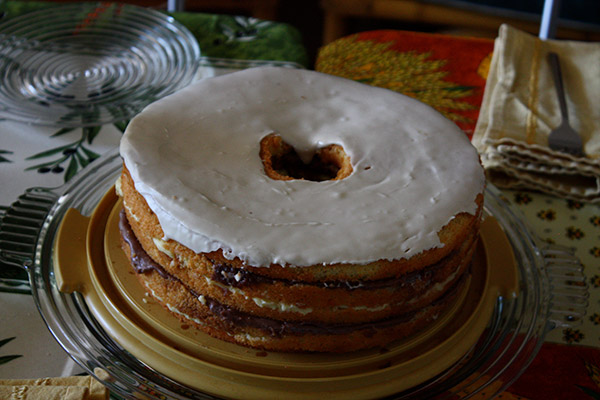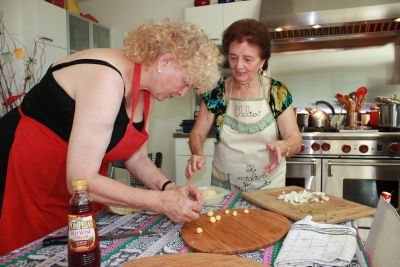In 2008, after raving about my mom’s cooking, “Il miglior ristorante é la Mamma,” as I would say, one of my clients flew her out to Los Angeles to do a weekend cooking class, all expenses paid. “Clelia’s Big Italian Feast,” was an interactive cooking experience for my client and friends who wanted to learn to prepare, cook, and bake Italian foods typical of southern Italy and in particular, Molise. It included il Pranzo di Sabato e la Cena di Domenica. We shopped the best Italian markets in L.A. and bought everything we needed per preparare la festa.
Saturday brunch consisted of panini imbottiti with Italian cheeses and meats, tomatoes, lettuce, and olives, insalata di aranci, and for dessert, scorpelles. Clelia chose to showcase scorpelle, one of her favorite recipes, the typical dessert of Carnivale in Molise and a cornerstone of traditional Molisana cuisine. Clelia’s is just one version of these popular carnival sweets that differ by village and family and are also known as scorpelle, bugie, cenci, chiacchiere, cròstoli, galani, lasagne, lattughe, pampuglie, rosoni sfrappole or frappe.
Sunday dinner included antipasti, zuppa, pasta al forno, polpette, braciola, e salciccia in salsa di pomodoro, followed by due contorni, spinaci e cavolfiore, prepared traditionally, steamed, and served cold with garlic, olive oil, vinegar, salt, and pepper. For dessert, Clelia decided on her homemade Pan di Spagna, the espresso and liquor-soaked layer cake with alternating vanilla and chocolate custard fillings. A beautiful ending to an amazing weekend of feasting on Italian food!
Pan di Spagna was our family’s typical New Year’s Day dessert, a layered sponge cake in the shape of a ring, which brought good luck the whole year. Once, while my older sister and I listened to the Top 100 Hits of the past year, I wandered into the kitchen to watch my mamma and grandma Nuccia craft this “mile-high” cake. After baking it, I watched in awe as my mom cut five beautifully thin, perfect layers. Then combining any alcohol from bottles that were nearly finished such as whiskey, anisette, rum, and vodka, with espresso in a clean syrup bottle with a squeeze-top cap, she soaked each layer with this potent mixture. It was unappetizing to the young me, but as an adult, I understand that after a large meal that was prepared all morning and eaten over an entire afternoon, this original version of the now-popular Tiramisú, was the perfect “pick-me-up.”
Pan di Spagna (Layered Sponge Cake)
This recipe is the one Nonna Nuccia made when I was a child. It is her sister Rosina’s recipe and the one that we have continued to make, keeping her traditional recipe alive on New Year’s Day.

Ingredients for the sponge cake:
- 8 Extra large Eggs divided - yolks in small mixing bowl and whites in large mixing bowl
- 1 T. Lemon juice or orange juice
- 1 ¼ C. Sugar
- 1 ¼ C. Cake flour
Directions:
Preheat oven to 325. Grease and flour a tube cake pan (angel food cake pan). Line the bottom of the pan with parchment paper.
Beat egg yolks with lemon at high speed for 10 minutes. Beat egg whites at max speed for 10 minutes until stiff then gently fold in sugar. Gently fold together both egg mixtures and the flour. Bake for 1 hour or until golden (cake will pull away from the sides of the pan slightly). Invert pan immediately and cool. Remove from pan. Cut into 5-7 layers depending on how high the cake rises.
Tips on cutting beautifully even layers:
I remember watching my mom at Nonna’s house on New Year’s Day cut this cake into very thin, even layers, using only her eyes as a guide and marveling at how accurately she did it. Lots of practice I suppose. But for us novices, there are many tips.
One is to use a paring knife to score the entire outside edge of the cake, not cutting too deeply, going slowly at eye-level. Next, using a large, serrated knife, cut through the cake along the indentation made by the paring knife then use the knife to lift the top layer and continue with the next layer.
Another tip is to measure and place toothpicks for each level and use the toothpicks as a guide for a serrated knife or dental floss.
There is also a fancy tool called a cake leveler to do the work for you and make each layer perfectly uniform, but that would not be the Clelia way!
Crema di Vaniglia e Cioccolato (Vanilla and Chocolate Custard)
Ingredients:
- 2 C. Milk (preferably whole)
- 4 Large egg yolks (use the whites for the frosting)
- 4 T. Sugar
- 4 T. Cake flour, sifted
- 1 Lemon rind
- For chocolate, add 2 T. Cocoa to the above ingredients.
Directions:
Combine all ingredients in a medium saucepan making sure there are no lumps. Cook over medium heat, stirring constantly, until it thickens. Cool in the refrigerator. Custard will thicken further when it is cooled. Remove lemon rind before putting cake layers together for Pan di Spagna.
In between layers:
Mix espresso and any alcohol that you have such as whiskey, Grand Marnier, Kahlua, Anisette, marsala, Irish cream, etc. Soak each layer with the espresso/liquor mixture and a layer of the crema (custard), alternating vanilla and chocolate.
Frosting for the Pane di Spagna:
Whip 4 egg whites until frothy. Add 4 C. powdered sugar a little at a time or to desired consistency. Most people add 1 tsp. vanilla. This was not in her recipe. We like to have it a bit runny so that when it is poured over the cake, it falls over the sides but does not pool onto the plate.



